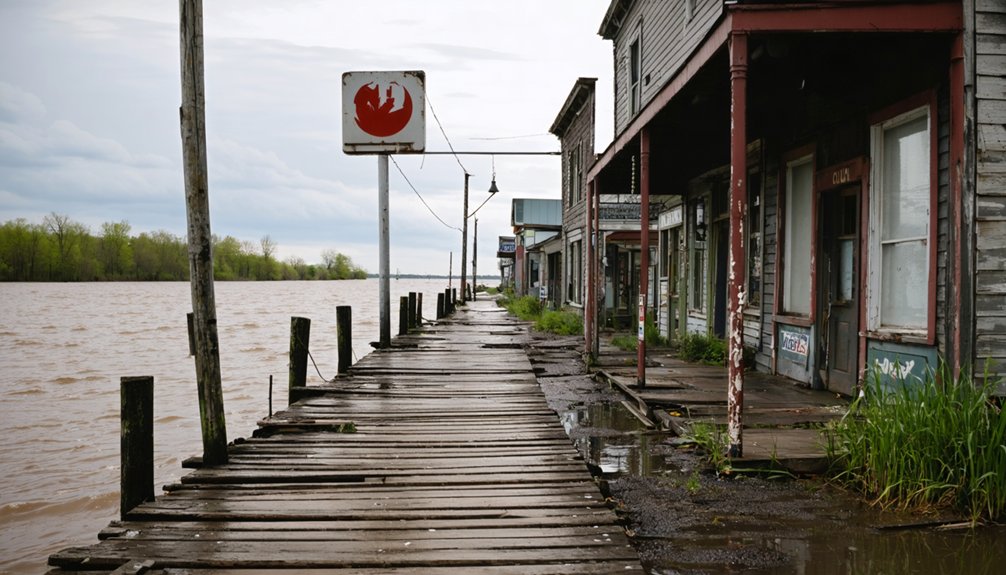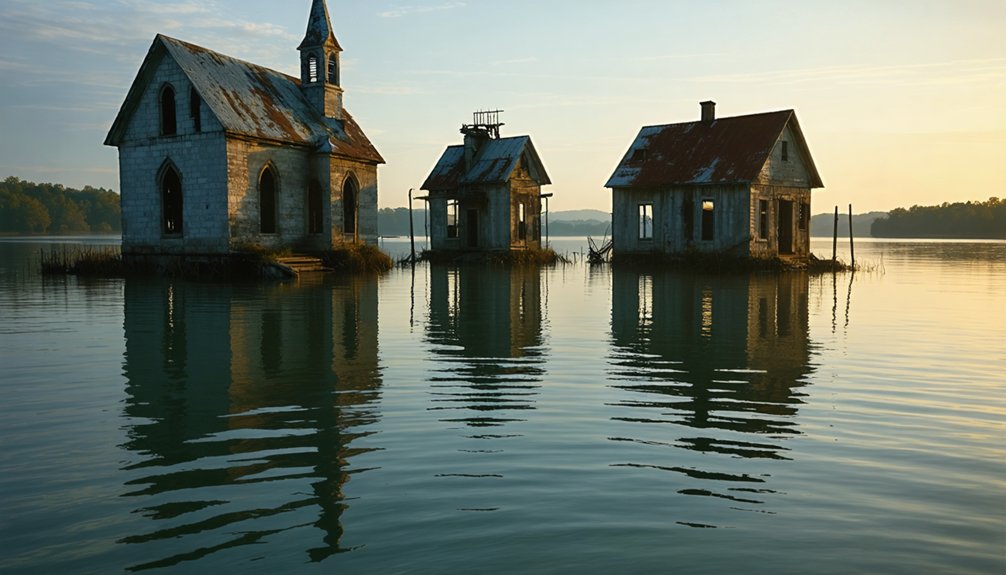Abandoned riverside towns in America disappeared due to changing infrastructure, economic collapse, and natural disasters. You’ll find ghost towns like St. Thomas submerged by reservoir projects, while others like Glenrio withered when highways bypassed them. Flooding repeatedly ravaged vulnerable communities along the Mississippi, accelerating population decline. Mining settlements followed boom-and-bust cycles, leaving only architectural remnants as nature reclaims these forgotten places. Their stories reveal the precarious relationship between human settlement and environmental forces.
Key Takeaways
- Infrastructure projects like reservoirs and highways bypassed or flooded established riverside communities, leading to their abandonment.
- Declining river transportation networks isolated once-thriving towns when railroads and interstates became preferred transportation corridors.
- Environmental vulnerabilities, particularly repeated flooding along major rivers like the Mississippi, accelerated community displacement and abandonment.
- Mining towns along rivers experienced boom-and-bust cycles, with many becoming ghost towns after resource depletion.
- Abandoned riverside towns preserve architectural remnants that reflect regional history while nature gradually reclaims these forgotten spaces.
The Ghost Towns Claimed by Water: Submerged American History
What happens when progress and human needs clash with established communities? Beneath America’s reservoir waters lie the sacrificed remains of once-thriving towns. The Tennessee Valley Authority, Garrison Dam, and Hoover Dam projects forced thousands to abandon their homes with minimal compensation, leaving behind cultural significance that can’t be quantified.
During droughts, you might glimpse foundations of the Gentry Hotel in St. Thomas or gravestones from Lake Texoma’s submerged cemeteries. These brief exposures offer windows into lost history, where Cherokee townsites and Blue Ridge communities were intentionally flooded and forgotten. In Elbowoods, North Dakota, the flooding for Lake Sakakawea displaced 325 families from the Fort Berthold Indian Reservation. The town of Proctor, North Carolina suffered a similar fate when it was completely submerged beneath Fontana Lake in the 1940s.
Today, archaeological efforts document these underwater ghost towns through specialized exploration and preservation initiatives. These submerged communities represent a sobering reminder of how infrastructure priorities reshaped America’s landscape—sometimes at devastating human cost.
Economic Collapse and Natural Disasters: Why Riverside Communities Failed
While submerged towns reveal one form of community loss, the slow death of riverside settlements through economic deterioration and natural calamities tells an equally compelling story.
You’ll find these communities caught in perfect storms where economic stagnation and environmental vulnerability collide. Traditional industries consolidated or relocated, triggering job migration and leaving hollowed-out economies with few prospects for young residents. West Alton, Missouri exemplifies this decline, with its population plummeting from 3,900 in 1970 to merely 360 residents after the 2019 flood.
- Flooding near the Mississippi caused 30% higher displacement rates, turning neighborhoods into condemned zones prone to arson and decay.
- Post-industrial collapse created devastating feedback loops—as businesses closed, more residents left, further eroding tax bases and services.
- Natural disasters beyond flooding, including hurricanes and tornadoes, accelerated abandonment throughout vulnerable river towns, particularly in the American South.
The interplay between recurring environmental threats and fragile economies made recovery virtually impossible for many communities. Similar to Youngstown, Ohio where economic strife contributed to a staggering 23.7% vacancy rate, these abandoned riverside towns represent the harsh reality of America’s forgotten communities.
Mining Booms to Abandoned Ruins: The Life Cycle of River Mining Towns
As gold and silver glimmered in the waters of America’s rivers during the 19th century, a distinctive pattern of civilization emerged that would dramatically transform the landscape.
You’d witness a predictable life cycle: riverside camps mushrooming into bustling hubs where placer mining operations took advantage of water access for processing ore and transportation.
These towns’ trajectories followed the minerals they extracted—coal, silver, gold, lead—rising rapidly as miners and their families built schools, churches, and saloons.
The fortunes of frontier settlements rose and fell with the minerals that birthed them, leaving cultural footprints in their wake.
Multicultural communities formed, creating rich cultural legacies as European immigrants brought their traditions to mining frontiers. These settlements became melting pots where stories of resilience and ambition shaped the cultural identity of America’s mining regions.
When surface deposits depleted, costly underground mining began.
Eventually, exhausted resources, market shifts, and environmental degradation triggered exodus.
Today, these abandoned shells preserve community memories in weathered buildings—silent reflections of America’s boom-and-bust mining heritage.
The harsh reality of mining life included numerous health hazards, with miners often growing thick mustaches as primitive filters against harmful coal dust and silica particles.
When the Roads Moved On: Transportation Changes and Town Abandonment
Transportation networks have served as the lifeblood of America’s riverside communities since the nation’s founding, yet these essential arteries proved fickle partners in town prosperity.
When railroads supplanted rivers, many towns adapted and thrived. However, the mid-20th century’s Interstate Highway System fundamentally altered this balance, bypassing once-vital rail and river hubs and plunging them into economic isolation. Antebellum settlements like Allen’s often disappeared entirely when corporate interests dictated that railroads create new towns rather than serve existing ones. The stark silence of Glenrio’s streets that once bustled with Route 66 traffic serves as a haunting reminder of how highway realignments devastated formerly prosperous communities.
- Once-thriving towns like Thurmond, WV became casualties when diesel locomotives replaced steam engines, eliminating the need for frequent servicing stops.
- Transportation infrastructure investments followed highways rather than reinforcing existing river-rail connections.
- Towns with high dependency on single transportation corridors lacked resilience when routes changed.
You’ll find these abandoned places frozen in time—victims of technological progress and shifting transportation economics that redirected America’s commercial arteries away from waterways and rails.
Architectural Remnants and Nature’s Reclamation of Forgotten Riverfronts
Hidden beneath tangles of persistent vegetation and decades of river silt, the architectural remnants of America’s abandoned riverside towns tell stories of both human ingenuity and nature’s patient reclamation.
You’ll find 19th-century churches and storefronts in places like Rodney, Mississippi, where Civil War-era structures stand defiant yet deteriorating. Cairo, Illinois, once a bustling trade center with steamboat traffic, now displays crumbling buildings along its once-busy streets. Local materials—brick, stone, and timber—reflect regional styles now slowly surrendering to environmental forces.
Kudzu and ivy embrace walls while flooding undermines foundations, creating an architectural preservation crisis that’s both challenging and costly. Accessing these forgotten places often requires navigating through kudzu-draped trees and crossing unstable bridges, as seen in the journey to Rodney.
The ecological impact is double-edged: wildlife claims these human-made habitats while repeated flooding deposits sediment that gradually buries history.
Preservation efforts must navigate this tension, documenting through photographs and salvaged artifacts what can’t physically be saved, balancing historical significance against nature’s persistent reclamation of these forgotten riverfronts.
Frequently Asked Questions
Can Abandoned Riverside Towns Be Legally Reclaimed by Private Citizens?
You can legally reclaim abandoned towns through adverse possession, auctions, or proper title acquisition, but you’ll face significant legal hurdles regarding property rights, environmental regulations, and jurisdictional complexities.
What Paranormal Occurrences Are Commonly Reported in Riverside Ghost Towns?
You’ll hear phantom footsteps echoing across abandoned docks as riverside ghost towns harbor intense hauntings history. Expect shadowy figures, disembodied voices, and cold spots—all tied to tragic mining accidents and frontier deaths.
Are There Any Successful Riverside Town Revitalization Projects?
You’ll find successful projects in Owensboro, Chattanooga, and Washington DC, where revitalization efforts transformed declining riverfronts through master planning, public-private partnerships, and multifunctional designs balancing recreation with ecological restoration.
How Do Indigenous Communities View These Abandoned Settler Towns?
From indigenous perspectives, these abandoned sites represent colonial dispossession but also failure of settler permanence. You’ll find they hold cultural significance as spaces for potential land reclamation and healing of ancestral connections.
What Health Hazards Exist in Abandoned Mining Towns Along Rivers?
Walking through a poisoned paradise, you’ll face invisible enemies: lead poisoning from contaminated soils, toxic waste in drinking water sources, acid mine drainage, and heavy metals embedded in riverbank sediments.
References
- https://whakestudios.com/us-ghost-towns/
- https://handbill.hk/editor_upload/file/1f47de58-e829-419c-ab5d-deae4a07d2ca.pdf
- https://www.smithsonianmag.com/travel/americas-coolest-ghost-towns-180952954/
- https://muncieneighborhoods.org/wp-content/uploads/2017/05/POLS-648-Abandoned-Housing-Report-20170502.pdf
- https://www.loveexploring.com/gallerylist/131658/abandoned-in-the-usa-92-places-left-to-rot
- https://www.youtube.com/watch?v=Mw68DVHUsDc
- https://www.geotab.com/ghost-towns/
- https://www.youtube.com/watch?v=e1Il6qGFF0Y
- https://www.lonelyplanet.com/articles/coolest-ghost-towns-us
- https://bestabandoned.com/abandoned-towns-in-usa/



